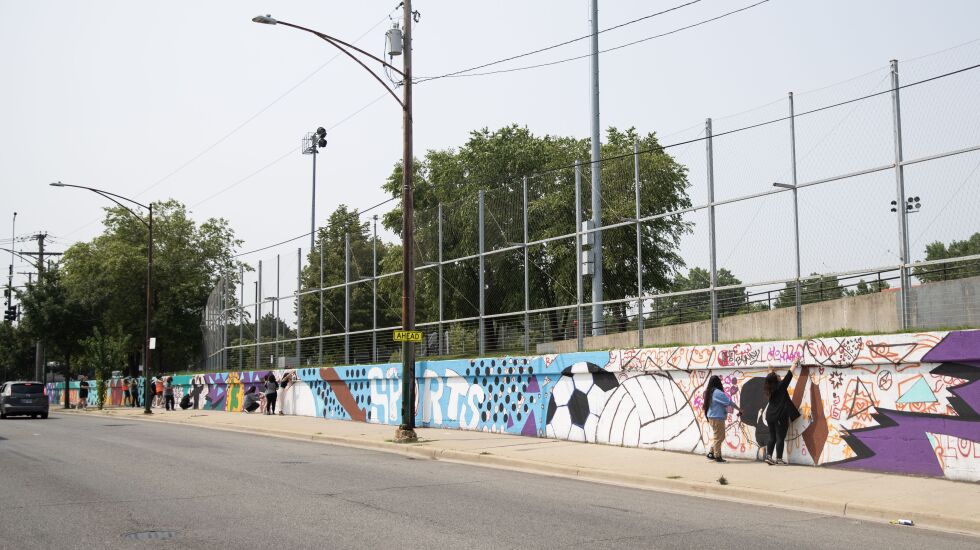
For graffiti artist and teacher Elizabeth “Bel” Reyes, her art has always been personal. Growing up in Archer Heights, Reyes found comfort and confidence in art classes that provided an outlet for her creativity. At the same time, she was grieving the loss of her older brother, who died at 14 in a car accident.
In eight grade, she found her brother’s journals with his writings and tags — and she discovered graffiti. That discovery fueled her imagination, and when she headed to Curie High School, she started to hang out with others doing graffiti, like her friend Mariel, and spending a lot of time in Little Village. “That’s where my story with Little Village begins,” says Reyes.
“Hanging out, diving into the neighborhood, and spending my teen years there with Mariel— we explored graffiti and made friends. During that time while I was exploring the art scene with these amazing artists in Pilsen, I was also exploring graff scenes in the ‘hood. And I was meeting young writers who were also into graff. Everything came together at once.”

“Graffiti is reclaiming spaces and putting your name up,” says Reyes. “It’s getting up, writing on stuff — and that doesn’t mean writing on anything, but on certain surfaces and reclaiming spots. Most importantly, it’s getting your name up.”
Reyes took pride in being among the few women putting her name up, while at the same time not wanting her gender to affect her art.
“[Graffiti]’s so male-dominated, I wanted [my tag] to be just a representation of my name in the graff scene, not of a girl doing graff. It was also something to prove to myself that it’s not just the guys that can do that — that I could do it, too. And I was doing it alone most of the time, so it was something that I was more secretly proud of.”
Reyes volunteered at Pros Arts Studio in Pilsen (run at the time by Jean Parisi) and immersed herself in other art forms, like clay-making and assisting with the kids’ circus. Eventually she was hired as an assistant.
“I knew this is what I wanted to pursue, to continue to make art,” she said.
Today Reyes is an award-winning teacher at Yollocalli Arts Reach in Pilsen, where she leads the Graffiti Mural Project class, in which students create “a graffiti mural that will positively reflect and impact the community.” This year’s session consisted of 13 students, ranging in age from 14 to 18, who painted a mural at the Rauner Family YMCA at 2700 S. Western Ave.

“We talk about graff in general,” says Reyes, “but also about the murals and graffiti within the community. We then come up with a mural design.”
Communities in neighborhoods like Little Village in South Lawndale face environmental and other health hazards, like crime and violence. To overcome these and other challenges, organizations like Yollocalli Arts Reach, a youth initiative founded by the National Museum of Mexican Art in 1997, are working to bring communities together. A safe space where teens and young adults can explore their creativity, Yollocalli offers free classes on subjects like photography, art vending, and radio, video and audio series production. For the mural class, the production is meant to emphasize the history and cultural heritage of Little Village.
“In Little Village, there are constantly productions being put up in the different communities that use certain stuff from our culture to represent, whether it’s some symbolism [like] flags or just showing pride in their culture through the stories they share. Other artists memorialize members of the community or those who have passed due to gang violence,” Reyes explains.
These and other colorful stories are being told in a muralist tradition that relies on a vocabulary of vintage, local and Latino pop culture references. What the art form invariably does, regardless of its regional varieties, is to spark conversations around shared experiences, which in turn creates connections within the community.

Although graffiti has its drawbacks — just holding a spray paint can is criminalized — Reyes believes it has a promising future. For the youth who are learning this art with Reyes, this form of expression can be a conduit for making intergenerational connections as they reflect on their personal experiences while digging into their families’ stories.
For Reyes, it’s a way to connect with her students and the community and to continue her brother’s legacy.
For more information about Yollocalli and its programs visit its website at Yollocalli.org







